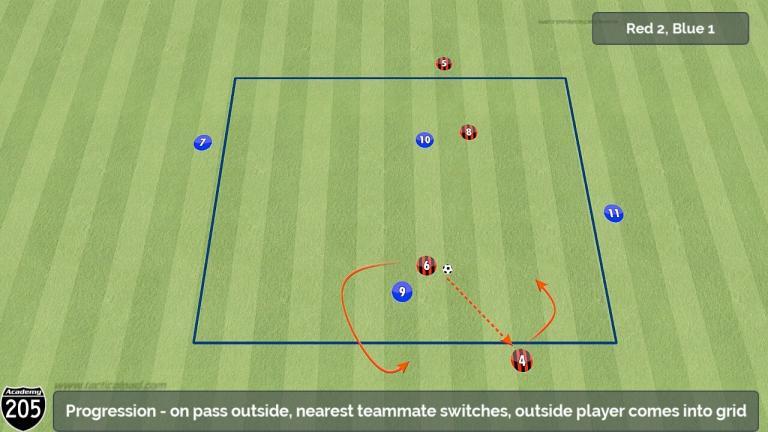2v2+2+2
Video
The activity begins in a grid with 2v2 on the inside and 2 teammates for each team on the outside – one team going North/South and the other team going East/West. The team in possession attempts to go from side-to-side. On change of possession, the game switches to the opposite orientation.
Scoring
Progressions/adjustments
- When the ball is played to an outside player from the inside, the player receiving the ball enters the grid and the nearest inside teammate moves to the outside.

- Place the interior players in a grid inside the larger grid – creating a minimum passing distance from inside-to-outside and vice versa.

What we like about this game
The game provides opportunities to develop technical and tactical skills in both the attacking and defending roles – on and off the ball. The rules are simple and can be quickly explained. The size and shape of the grid can be adjusted to accomodate different ages and stages. The progressions provide opportunities to introduce new themes: first touch anticipation and execution, adjustment of 1st/2nd defensive roles based on positioning and movement of incoming attacker. Ideally, the activity is fast-moving, high physical intensity, and engaging for the players.
Relationship to the full game
In this example from an 11v11 game, we are trying to progress the ball from our back to our forward through our midfield players. The intent is to quickly (if possible) break lines. In the defensive role, the opposing midfielders are trying to delay, close off through balls, force the ball backward and, if possible, win the ball and initiate a counterattack.

Coaching points
For the attackers, a key to success in creating a rhythm is the movement of the 3rd player – the “other” central player when the ball is played through the middle. As the ball is played from inside to outside, we want to encourage the 3rd player to move into a supporting position ready to receive the next pass from outside to inside. The body shape, angle, and first touch of the 3rd player should support a simple transition of the ball from one side to the other. If the pass from inside to outside is blocked off, we want to encourage the 3rd player to find a supporting angled position so that their partner can make a diagonal pass with the next pass going forward.
For the defenders, communication and vision are important elements to prevent the ball from progressing and potentially regaining possession. Although the game can become 2 1v1s (with each central defender matching up against an opponent), the defenders must also attempt to position to prevent a split. In the progression with outside players entering the grid, the defender on the player going outside must immediately switch onto the player entering the grid to prevent an uncontested pass to the opposite side.
Adjust for numbers
With 6 players, place the two outside players in an East/West orientation and remove North/South. The outside players become true neutrals, playing to whichever team plays them the ball. This removes the progression of players entering from the outside.



Summary
The 2v2+2+2 is a fast-paced game that provides learning opportunities for both attackers and defenders. With quick transitions, there are many teachable moments for players are different ability levels. Adjustments to size and shape of the pitch and numbers of players make this a flexible activity that is suitable for a variety of ages and abilities.